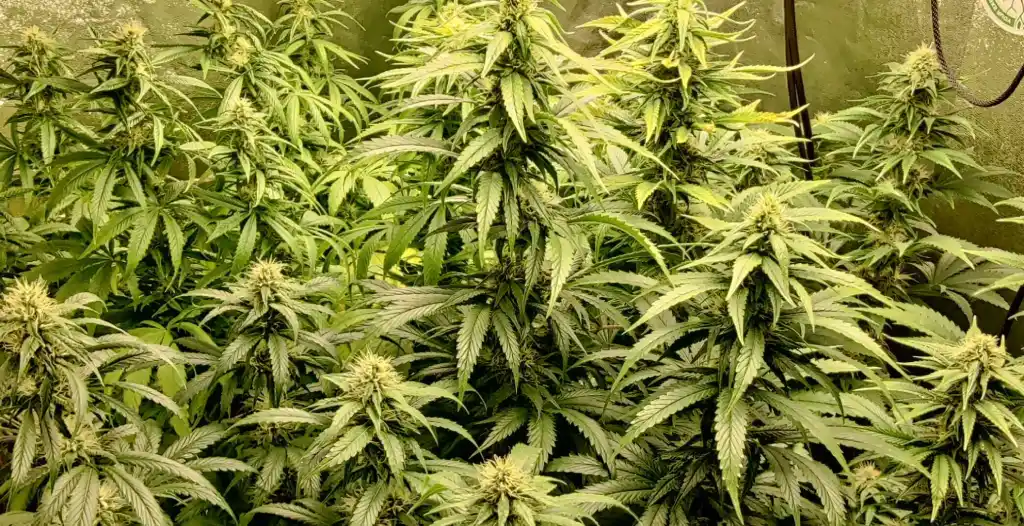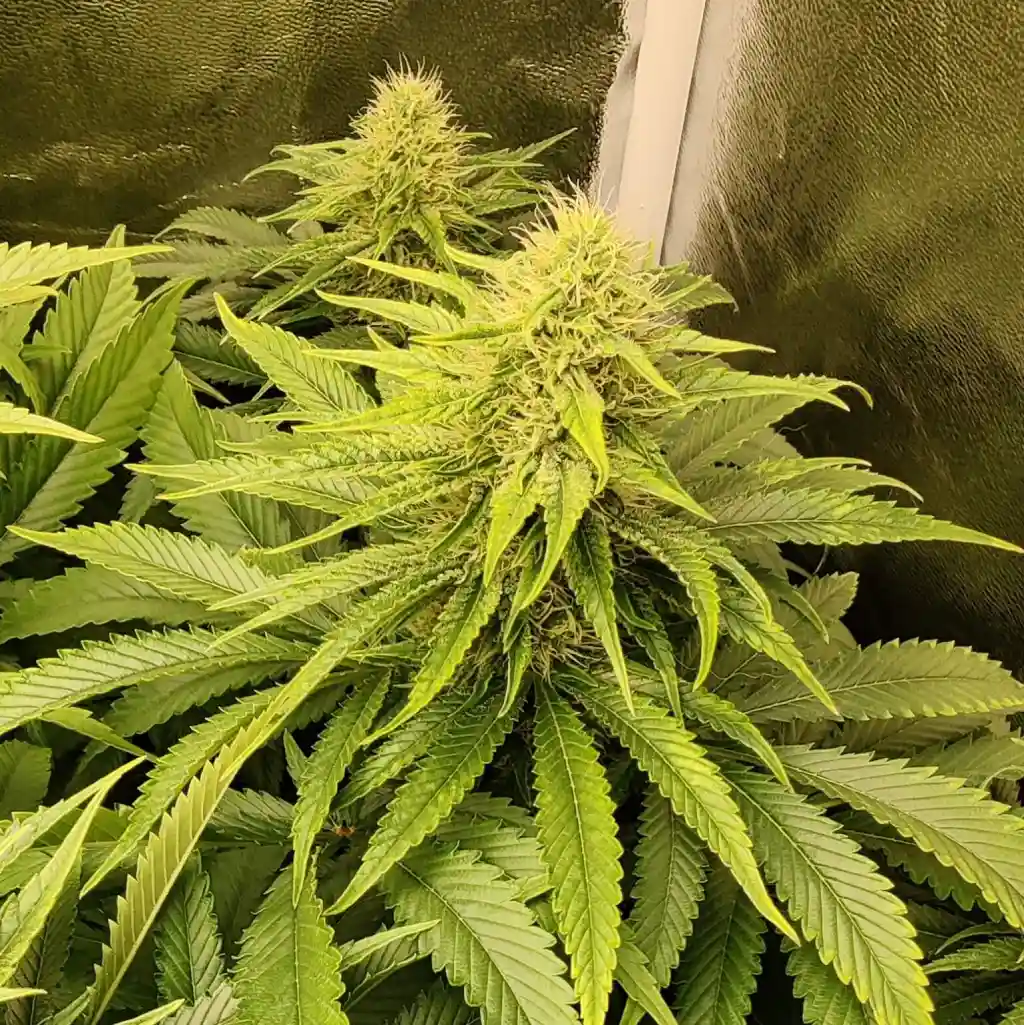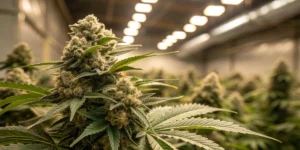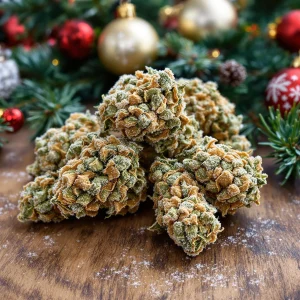Himalaya Gold Strain Description
The Himalaya Gold Strain is an Indica-dominant hybrid admired for its potent effects and flavorful profile. Originating from Nepal and North India, this strain combines landrace genetics to deliver a robust cannabis experience. Its dense, trichome-covered buds feature earthy, peppery aromas complemented by sweet, spicy undertones.
Growers value the Himalaya Gold Strain for its adaptability and high yields. Whether cultivated indoors or outdoors, it thrives in a variety of environments, producing consistent results. Its balance of potency and ease of cultivation makes it a standout for beginners and seasoned growers alike.
Environmental Requirements for Growing Himalaya Gold Strain
The Himalaya Gold Strain thrives in temperate to warm climates, reflecting its Himalayan origins. Ideal temperatures range from 21°C to 27°C (70°F to 80°F) with moderate humidity levels to prevent mold and mildew. Its natural tolerance for cooler nights adds to its versatility.
Indoor growers should replicate these conditions with controlled setups, ensuring optimal temperature and humidity levels. Outdoors, this strain benefits from nutrient-rich soil and consistent sunlight. Meeting these requirements ensures vigorous growth and high yields.
Setting Up the Growing Cannabis Space for Himalaya Gold Strain
Creating an ideal growing environment for the Himalaya Gold Strain maximizes yield and quality. Indoors, ample space and efficient lighting, such as LEDs or HPS, are essential. Proper airflow and humidity control prevent mold and promote healthy development.
Outdoors, this strain thrives in well-draining, nutrient-rich soil under direct sunlight. Regular maintenance, including pruning and training, enhances airflow and light penetration. A well-prepared grow space ensures optimal conditions for a robust harvest.
Indoor Cannabis Cultivation
The Himalaya Gold Strain performs exceptionally well indoors with controlled environments. Use full-spectrum LED lights to provide consistent energy during all growth stages. SCROG techniques help manage plant height and optimize light exposure to lower branches.
Maintain soil pH between 6.0 and 6.5 for efficient nutrient absorption. Monitor humidity levels to avoid mold, especially as the plants mature. A carefully managed indoor setup produces dense, resinous buds with rich flavors.
Outdoor Cannabis Cultivation
Outdoors, the Himalaya Gold Strain grows vigorously when planted in nutrient-dense soil. Its natural resilience to pests and cooler temperatures makes it ideal for a range of climates. Ample sunlight and regular pruning are crucial for promoting healthy growth.
This strain can reach impressive sizes outdoors, delivering high yields by late October. Its robust structure and Himalayan genetics ensure consistent results, even in less-than-ideal conditions. Growers can expect flavorful, aromatic buds with proper care.
Propagation and Germination of Himalaya Gold Strain
The Himalaya Gold Strain is easy to propagate from seeds or clones. For seeds, germination is achieved by placing them between moist paper towels in a warm, dark area. Once the taproot emerges, transfer the seeds to pots with well-draining soil.
Cloning offers another reliable propagation method. Select healthy mother plants and use sterilized tools for cuttings. Keep clones in a humid environment during the rooting phase to ensure success. Both methods produce healthy plants ready for cultivation.
Vegetative Phase of Himalaya Gold Strain
During the vegetative phase, the Himalaya Gold Strain displays rapid growth and lush foliage. Provide at least 18 hours of light daily, either from natural sunlight or full-spectrum LEDs. Nitrogen-rich fertilizers support vigorous development during this stage.
Pruning helps maintain airflow and prevents overcrowding as the plant grows bushy. Shaping the plant ensures light reaches lower branches, promoting even growth. A strong vegetative phase sets the stage for a productive flowering phase.
Flowering Phase of Himalaya Gold Strain
The Himalaya Gold Strain typically flowers within 8 to 9 weeks. Adjust the light schedule to 12 hours of light and 12 hours of darkness indoors to trigger flowering. Phosphorus and potassium-rich nutrients are crucial during this phase to enhance bud production.
Humidity should be reduced to prevent mold on the dense buds. Monitor environmental conditions closely and avoid excessive pruning to allow the plant to focus energy on bud formation. This phase results in a harvest of aromatic, resin-rich buds.
Cannabis Fertilization and Nutrition
The Himalaya Gold Strain requires balanced nutrition throughout its lifecycle. During the vegetative phase, nitrogen-heavy fertilizers support robust growth. Transition to phosphorus and potassium-rich feeds in the flowering phase to encourage bud development.
Organic amendments like compost or bat guano enhance soil quality and terpene production. Regularly test soil pH to ensure optimal nutrient absorption. A well-planned feeding schedule ensures healthy plants and high-quality harvests.
Pest and Disease Control for Cannabis Growing
Prevention
The Himalaya Gold Strain is naturally resistant to some pests but benefits from preventive measures. Inspect plants regularly for signs of infestation, and use neem oil or beneficial insects like ladybugs to deter pests. Maintain airflow and moderate humidity to reduce the risk of mold and mildew.
Corrective Actions
If pest problems arise, natural insecticides such as pyrethrin are effective. For diseases like powdery mildew, reduce humidity and increase airflow immediately. Quick intervention protects the plant and ensures a successful harvest.

Harvesting and Curing for Cannabis Growing
The Himalaya Gold Strain reaches peak potency and flavor when its trichomes turn from clear to milky white with a touch of amber. Harvesting at this stage ensures optimal cannabinoid and terpene profiles. Use sterilized tools to cut branches, trim away excess fan leaves, and hang them upside down in a dark room. Maintain a consistent temperature of 20°C (68°F) and 50% humidity to ensure slow, even drying.
Curing enhances the overall quality of the buds by preserving their terpenes and potency. After drying, place the trimmed buds into airtight glass jars. Open the jars daily for the first week to release moisture, then reduce ventilation frequency. A curing period of at least two to three weeks will maximize the flavor and aroma, elevating the final product’s appeal.
Is Himalaya Gold Strain Indica or Sativa?
The Himalaya Gold Strain is predominantly Indica-dominant, with effects tailored for relaxation and stress relief. Its lineage from the Himalayan region contributes to its soothing qualities, making it a favorite for those seeking nighttime relaxation. Its physical effects are complemented by a calming mental experience, offering a well-rounded high.
While it leans heavily toward Indica characteristics, this strain carries subtle Sativa traits that keep the effects balanced. Users report a clear-headed sensation alongside its relaxing qualities, making it suitable for unwinding without overwhelming drowsiness. Its versatility appeals to both recreational and medicinal consumers.
Advantages of Growing Himalaya Gold Strain
One of the key advantages of the Himalaya Gold Strain is its ease of cultivation. This strain is resilient against common pests and mold, making it ideal for novice growers or those in climates with fluctuating conditions. Its high yield potential, especially outdoors, ensures a rewarding harvest for commercial and personal growers alike.
Another benefit is its adaptability to various growing conditions. It performs well in both indoor and outdoor environments, requiring minimal maintenance when provided with the right nutrients and care. Additionally, its potent effects and unique flavor profile make it a sought-after choice in the cannabis market.
Disadvantages of Growing Himalaya Gold Strain
Despite its strengths, the Himalaya Gold Strain has a few challenges. Its relatively tall growth can be an issue for indoor growers with limited space, requiring height management techniques like topping or SCROG. Proper planning is essential to avoid overcrowding in smaller grow areas.
Another downside is its slightly longer flowering period, which ranges from 8 to 9 weeks. While this is manageable for most growers, those seeking a quicker harvest might find it less appealing. These factors should be considered when planning a grow cycle for this strain.
Problems in Cultivating Himalaya Gold Strain
Overfeeding is a common issue when growing the Himalaya Gold Strain, as it has moderate nutrient requirements. Excessive fertilization can lead to nutrient burn, causing discoloration and stunted growth. Monitoring nutrient levels and following a balanced feeding schedule are crucial to maintaining healthy plants.
High humidity levels during the flowering phase can also pose a risk, as the dense buds are susceptible to mold. Maintaining proper airflow and reducing humidity is essential for avoiding mold-related losses. These proactive measures ensure a healthier and more productive grow cycle.
Advanced Pest Control for Cannabis Growing
For severe pest infestations, advanced control methods can protect the Himalaya Gold Strain without harming the plants. Biological pest control, such as introducing predatory insects like lacewings or ladybugs, is an eco-friendly solution to manage aphids and mites effectively.
Horticultural soaps and Bacillus thuringiensis (Bt) are excellent for managing pests like caterpillars and larvae. These methods target specific issues while preserving the plant’s overall health. Combining prevention with targeted treatments ensures a pest-free grow environment and maximizes yield potential.
Similar Strains
Growers who enjoy the Himalaya Gold Strain may find Afghan Kush a compelling alternative. Both strains originate from mountainous regions, sharing robust growth characteristics and natural resilience to pests and environmental challenges. Afghan Kush also boasts a rich, earthy flavor and strong Indica effects.
Another comparable strain is Northern Lights, known for its ease of growth and potent relaxation effects. Like Himalaya Gold, Northern Lights is suitable for beginners and delivers high yields. Both strains are excellent options for cultivators seeking reliable and rewarding plants.
Week-by-Week Growth Plan for Himalaya Gold Strain
Week 1-2 (Germination)
Begin by placing Himalaya Gold seeds in a warm, moist environment, such as between damp paper towels or in a seed starter kit. Maintain consistent temperatures between 75-80°F (24-27°C) and ensure humidity levels around 70-80%. Check daily for taproot development, which usually occurs within 2 to 5 days. Avoid letting the medium dry out but prevent waterlogging to reduce the risk of mold or rot.
Once taproots are visible, transfer the germinated seeds into small pots filled with light, nutrient-free soil or a seedling mix. Provide gentle lighting to encourage sprouting while avoiding excessive heat or stress on the delicate seedlings.
Week 3-4 (Seedling Stage)
After sprouting, Himalaya Gold seedlings require 18 hours of light daily to support early development. Use energy-efficient LED grow lights positioned 12-18 inches above the plants to provide sufficient light without causing heat stress. Maintain soil moisture by watering lightly and frequently, ensuring even hydration without oversaturating the roots.
Introduce a mild nutrient solution designed for seedlings, focusing on essential micronutrients like calcium and magnesium. Keep temperatures stable at 70-75°F (21-24°C) with a humidity level of 65-70% to create an ideal environment for steady growth.
Week 5-6 (Early Vegetative)
Himalaya Gold plants will experience rapid growth during the early vegetative phase. Begin feeding with nitrogen-rich nutrients to support the development of robust stems and foliage. Monitor plant height and adjust the grow lights to maintain a consistent distance, ensuring even light coverage across all plants.
Increase airflow using fans to strengthen stems and reduce the risk of fungal issues. Maintain temperatures at 72-82°F (22-28°C) with humidity levels around 60-65%. Regularly inspect the plants for signs of nutrient deficiencies or pests, addressing any issues promptly.
Week 7-8 (Late Vegetative)
As Himalaya Gold transitions into its late vegetative stage, the plants will exhibit more significant height and width. This is an excellent time to implement training techniques like Screen of Green (SCROG) to maximize canopy space and improve light penetration to lower bud sites. Gently bend and secure branches to encourage even growth.
Continue feeding nitrogen-heavy nutrients and maintain an 18-hour light cycle. Reduce humidity slightly to 55-60% to prepare the plants for the upcoming flowering phase. Regularly prune excess foliage to improve airflow and direct energy toward productive growth sites.
Week 9-10 (Transition to Flowering)
Gradually transition the light cycle to 12 hours of light and 12 hours of darkness to trigger flowering. During this period, plants may experience a growth spurt, often referred to as the “flowering stretch.” Introduce phosphorus-rich nutrients to support bud development while maintaining moderate nitrogen levels.
Adjust humidity to 50-55% and monitor for any signs of stress or pests. Ensure consistent airflow and consider installing carbon filters to manage the strain’s aromatic emissions during flowering.
Week 11-14 (Flowering Phase)
Himalaya Gold enters its full flowering stage, with buds beginning to form and resin production increasing. Reduce nitrogen levels in favor of phosphorus and potassium to enhance bud size and density. Maintain a consistent 12/12 light cycle and monitor trichome development closely.
Humidity levels should be reduced to 40-50% to prevent mold or mildew, especially as the buds thicken. Inspect plants daily for signs of pests or nutrient deficiencies, making adjustments as needed to maintain optimal health and productivity.
Week 15-16 (Late Flowering)
During the late flowering stage, buds reach their peak size and resin production. Lower humidity to 35-40% and ensure strong airflow to protect against mold. Begin flushing the plants with pure, pH-balanced water to remove nutrient buildup, improving the final flavor and smoothness of the buds.
Monitor trichomes using a magnifying glass or microscope. Harvest is near when most trichomes are cloudy with some turning amber, indicating peak potency and desired effects.
Week 17 (Harvest)
When the trichomes are at the optimal stage, cut the branches at the base and hang them upside down in a dark, well-ventilated room. Maintain temperatures around 68°F (20°C) and humidity at 50% during the drying process, which typically takes 7-10 days. Avoid rushing this stage, as proper drying is critical for preserving the strain’s flavor and potency.
Trim excess leaves and sugar leaves after drying to prepare the buds for curing. Handle the buds gently to avoid damaging the trichomes.
Week 18-19 (Curing)
Place dried buds into airtight glass jars, filling them about 75% full to allow some airflow. Store the jars in a cool, dark place and open them daily for 10-15 minutes during the first two weeks to release excess moisture. This burping process prevents mold and allows the buds to cure evenly.
Curing for 2-4 weeks enhances the flavor, aroma, and potency of Himalaya Gold, ensuring a smooth and enjoyable smoking or vaping experience. Longer curing times can further refine the strain’s profile, making it even more desirable for connoisseurs.
This week-by-week growth plan provides a comprehensive guide for cultivating Himalaya Gold Strain successfully. Always adapt your approach based on environmental factors and the specific needs of your plants.

FAQs About Himalaya Gold Strain
What is the THC percentage of Himalaya Gold Strain?
The Himalaya Gold Strain typically has THC levels ranging from 15% to 18%, offering a balanced potency. Its THC content provides deeply relaxing effects ideal for stress relief, making it a popular choice for both recreational and medicinal users.
How long does it take for Himalaya Gold Strain to flower?
This strain has a flowering period of approximately 8 to 9 weeks. During this time, its buds develop dense trichomes, offering a visually appealing harvest with strong effects and a rich terpene profile.
What flavors and terpenes are present in Himalaya Gold Strain?
The Himalaya Gold Strain features earthy, peppery flavors with hints of spice. Its dominant terpenes include myrcene and caryophyllene, which contribute to its aromatic profile and relaxing effects.
Can Himalaya Gold Strain be grown both indoors and outdoors?
Yes, this strain is highly versatile and adapts well to indoor and outdoor setups. Its natural resilience makes it a reliable option for growers in various climates, delivering high yields in both environments.
What are the medicinal benefits of Himalaya Gold Strain?
Known for its relaxing effects, the Himalaya Gold Strain helps alleviate stress, muscle pain, and insomnia. Its balanced profile provides physical relaxation without heavy sedation, making it suitable for day or night use.





